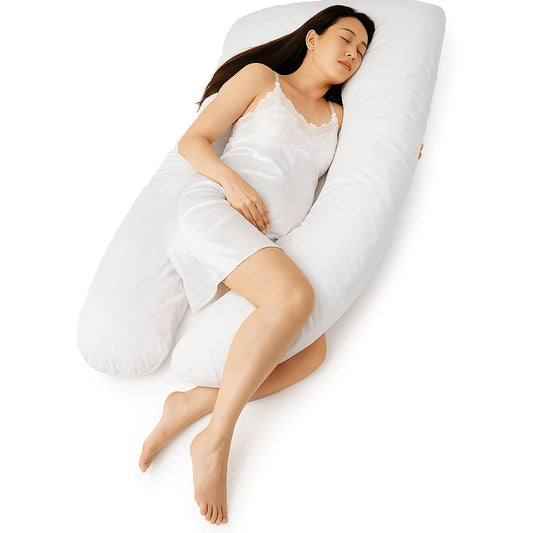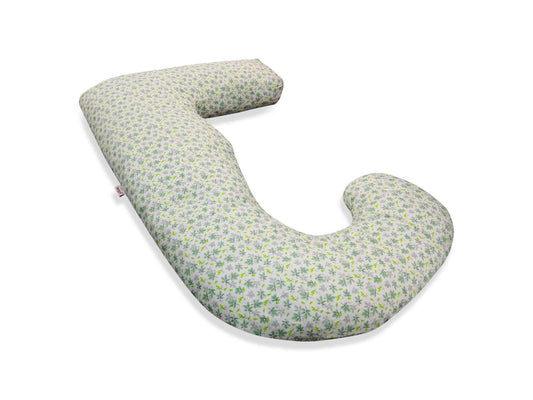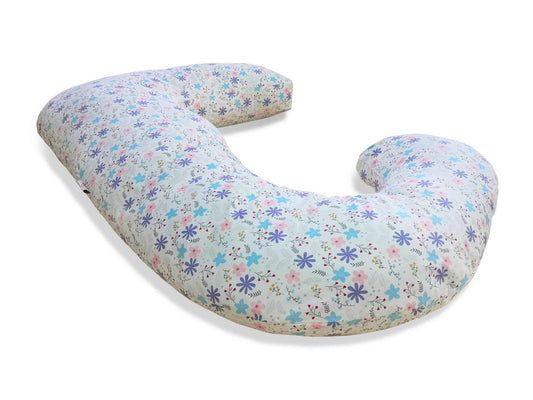From Bump to Baby: How Pregnancy Pillows Support Every Stage

Why Pregnancy Pillows Matter From First Flutters to First Feeds
Pregnancy changes everything about how you rest — from where you feel pressure to how long you can stay in one position. As your centre of gravity shifts, you may notice new hotspots at the hips, lower back, and shoulders, plus a growing need to support the bump without tensing your core. A well-chosen pregnancy pillow fills those gaps, encouraging side sleeping, stacking the hips and knees, and reducing micro-awakenings so sleep feels more continuous.
Early Weeks & First Trimester: Set the Foundation
Even if a bump isn’t visible yet, early hormonal shifts can make sleep unpredictable. This is a great time to build easy habits and introduce light positioning support.
- Ease into side sleeping: hug a J-shaped body pillow in front to simulate stomach-style comfort while you gradually switch to your side.
- Reduce shoulder & chest pressure: place a slim section of the pillow between the knees and ankles to keep hips stacked and upper body relaxed.
- Stop the late-night “brace”: add a small lift under the lower abdomen so your core isn’t working to hold the bump as it grows.
Want a primer on the basics? Read How to Sleep Soundly During Pregnancy for routine and environment tweaks that pair perfectly with a pillow.
Second Trimester: Bump Support & Hip Alignment
As the bump becomes heavier, the priority shifts to alignment and stability. Keeping knees and ankles stacked reduces torque at the hips and eases the lower back. Many people find the sweet spot with one of these set-ups:
- U-shape “all-rounder”: one side cradles the bump while the other supports your back so you’re less likely to roll flat. Easy for combination sleepers.
- J-shape “targeted”: compact, cooler, and easy to swing from sofa to bed. Thread the tail between the knees; tuck the curve lightly under the bump.
- Elongated C-shape “flex”: fold or loop it to fine-tune support where your body needs it most without crowding the bed.
For a deeper dive on sleep-space tweaks (light, airflow, layers), see Your Sleep Matters: Crafting the Ultimate Sleep Environment.
Third Trimester: Max Stability, Less Night-Time Fuss
In late pregnancy, small gains create big relief. Focus on minimising rotation, easing back strain, and taming heartburn or breathlessness.
- Lock in side sleeping: use a U-shape to support both front and back, or pair a J-shape with a slim knee pillow for hip comfort.
- Help heartburn: raise your upper body slightly; keep a gentle lift under the bump and stick to the left side where possible.
- Soothe legs & pelvis: float calves or ankles on a soft section of the pillow to reduce swelling and night cramps.
Postpartum: Meet Your Multi-Tasker
Good news: a quality pregnancy pillow earns its keep after baby arrives. Most shapes double as day-and-night helpers for the fourth trimester and beyond.
- Feeding support: use a U- or C-shape to position baby for bottle or breastfeeding while protecting your back and shoulders.
- Recovery comfort: gentle elevation and hip stacking ease strain after vaginal birth or C-section (always follow your clinician’s guidance).
- Everyday lounging: set up a supportive “nest” for story time, rest breaks, or contact naps (keep adult pillows clear of baby’s sleep surface).
Planning for recovery? Save Postpartum Recovery: What to Expect After Birth and C-Section Recovery: Tips to Rest Well and Sleep Better.
Which Shape Fits Your Life (Not Just Your Bed)
- U-Shaped Pregnancy Pillow: best for combination sleepers and anyone who rolls often; stable, balanced, and great for late pregnancy.
- J-Shaped Body Pillow: compact and cooler; ideal in smaller beds and handy for sofa sessions or travel.
- Elongated C-Shaped Body Pillow: most adaptable; fold, loop, or tie for custom support — also useful as a nursing bolster.
Unsure where to start? If you want one pillow for the whole journey, a U-shape is the most “forgiving.” If you sleep warm or share a smaller bed, the J-shape is a smart pick.
Positioning Playbook (Quick Wins)
Side Sleeper
- Thread the pillow between knees and ankles to keep hips stacked.
- Add a light lift under the bump so your core can relax.
- Place a supportive section behind the back to prevent rolling.
Back Sleeper Transition
- Use a J-shape to guide you onto your side at a gentle angle.
- Elevate your upper body slightly if you’re dealing with heartburn.
Restless/Combination Sleeper
- Choose a U-shape for easy side-to-side turns without flipping the pillow.
- Keep layers breathable so temperature swings don’t wake you.
Real-World Routines That Make Pillows Work Harder
- Daylight dose: 10–20 minutes of morning light to steady your body clock.
- Wind-down stack: dim lights → warm shower or gentle stretch → phone away → a few pages of something soothing.
- Evening meals: finish larger meals 2–3 hours before bed; elevate slightly if reflux flares.
- Breath reset: 6 slow nasal breaths (4–6s in / 6–8s out) as you settle into the pillow.
Pair these with our quick guides: Comprehensive Guide to Comfortable Sleep and Day 1 of the 7-Day Sleep Comfort Plan.
FAQ: Pregnancy Pillows & Every Stage
When should I start using a pregnancy pillow?
Start as soon as you notice discomfort or want to build good habits — many people begin in the second trimester, but earlier is fine.
Which shape is best if I change sides a lot?
A U-shaped pregnancy pillow offers balanced front-and-back support so you can turn without resetting the whole setup.
Will I still use it after birth?
Yes. Most shapes transition into feeding support, recovery comfort, and everyday lounging.
Can a pregnancy pillow help with heartburn?
It can. Slight upper-body elevation plus left-side sleeping and light bump support often helps reduce reflux at night.
This article shares lifestyle and comfort suggestions only. It is not medical advice. Always consult your midwife or healthcare professional for personalised care.

















